
Google Just Flipped a Hidden Switch - And 87.7% of Websites Lost Impressions Overnight
Google just flipped a hidden switch that made 87.7% of websites lose impressions overnight. No warning. No press release. Just—boom—your traffic graph falls off a cliff.
And here's the kicker. This one tiny change made scraping tools 10 times more expensive, broke rank trackers, and sent agencies and startups into panic mode.
But that's just it—this isn't just about SEO. It's about Google fighting back against AI, and the survival of your business in the new search era.
Let me explain exactly what happened, why Google did it, and the one simple move you need to make this week to stay ahead.
Want the exact tools and templates I use to navigate these SEO shifts? Join my free Smart AI Business Hub with updated tutorials on SEO, AI optimization, content strategy, and more. It's updated every time a major change like this drops.
What Actually Changed (And Why Your Dashboard Looks Broken)
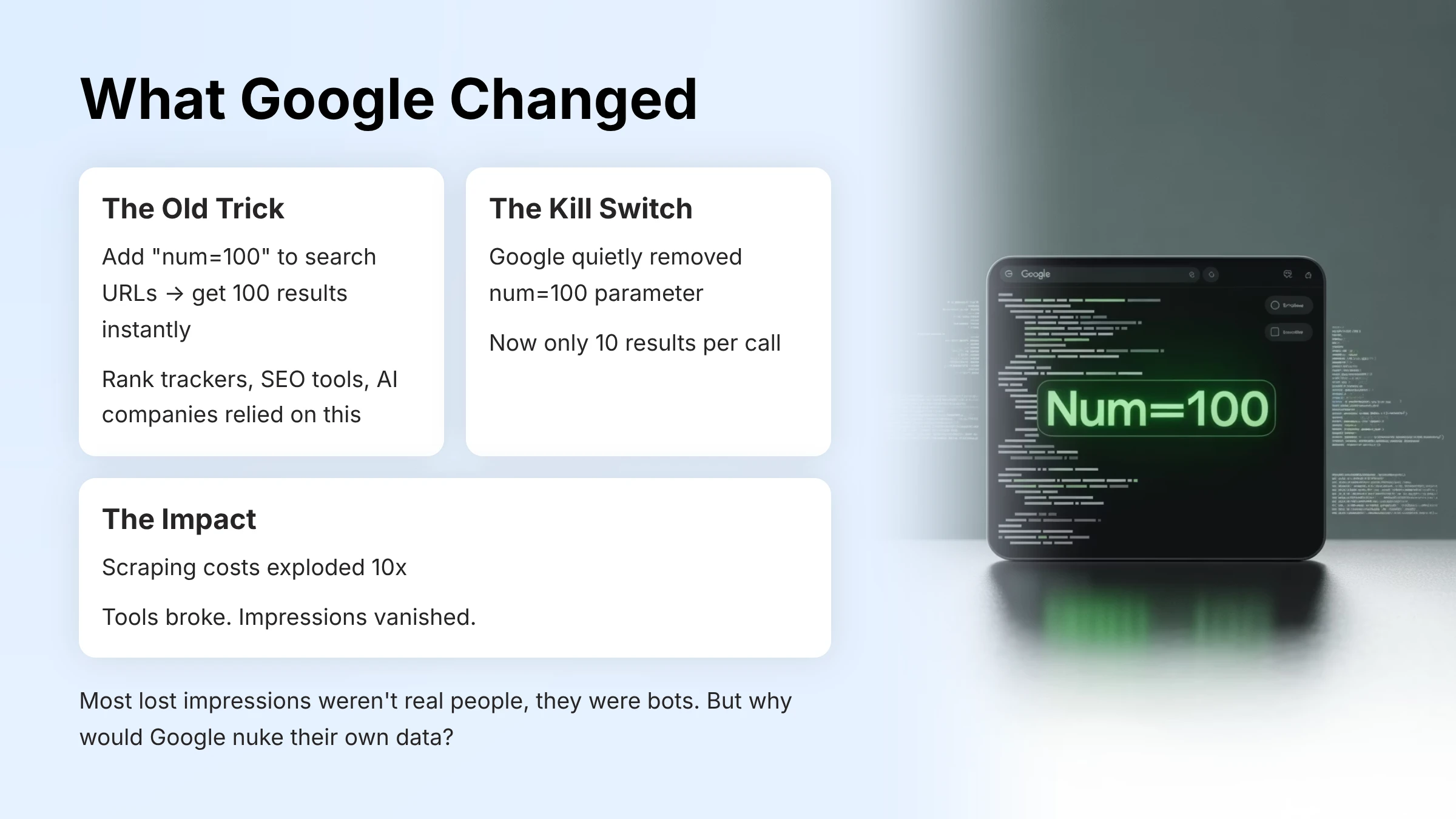
For years, there was a hidden trick in Google's search. Add "num=100" to your search URL, and you'd get the top 100 results in one go. Rank trackers, SEO tools, and even AI companies relied on this to pull massive amounts of data—fast and cheap.
But last month, Google quietly killed the num=100 parameter. Now, you only get 10 results per call. That means scraping 100 results costs 10 times more.
Tools broke. Costs exploded. And for most sites, impressions in Google Search Console just... vanished.
The truth is, most of those lost impressions weren't real people. They were bots.
The Shockwave That Hit 87.7% of Sites
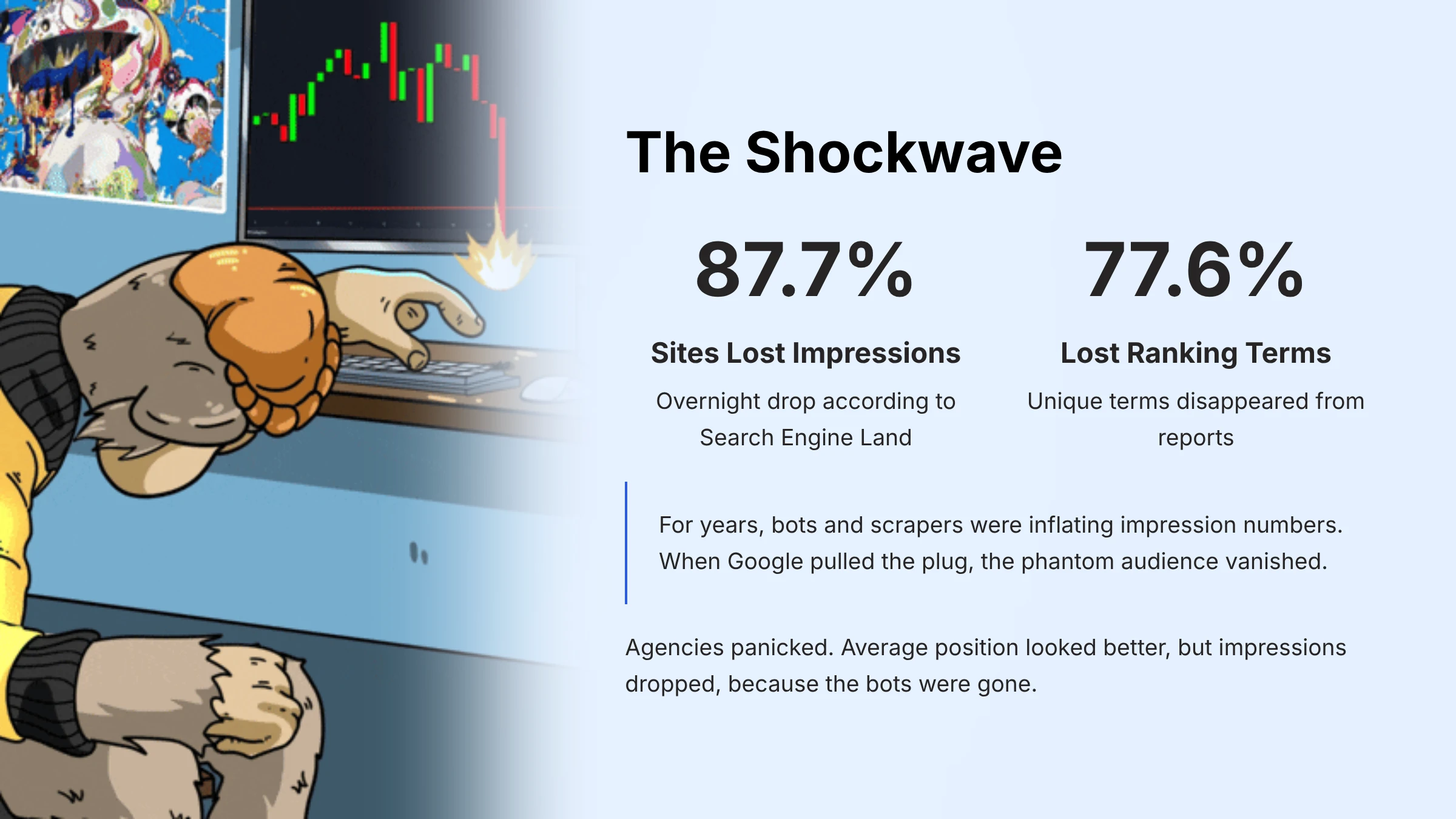
The impact was instant. According to LOCOMOTIVE Agency's analysis of 319 properties, here's what happened:
87.7% of sites lost impressions—overnight
77.6% of sites lost unique ranking terms
Short-tail and mid-tail keywords took the biggest hit
Average position improved artificially (more on this in a second)
One agency even thought they'd been hit by a penalty—until they realized it was just the num=100 switch.
But here's what really happened. For years, bots and scrapers were inflating your impression numbers. When Google pulled the plug, it was like a phantom audience got up and left the theater.
Suddenly, your average position looked better—but your impressions dropped, because the bots were gone.
Don't get me wrong—your site didn't actually tank. The data just got more real.
Why Google Nuked Their Own Data
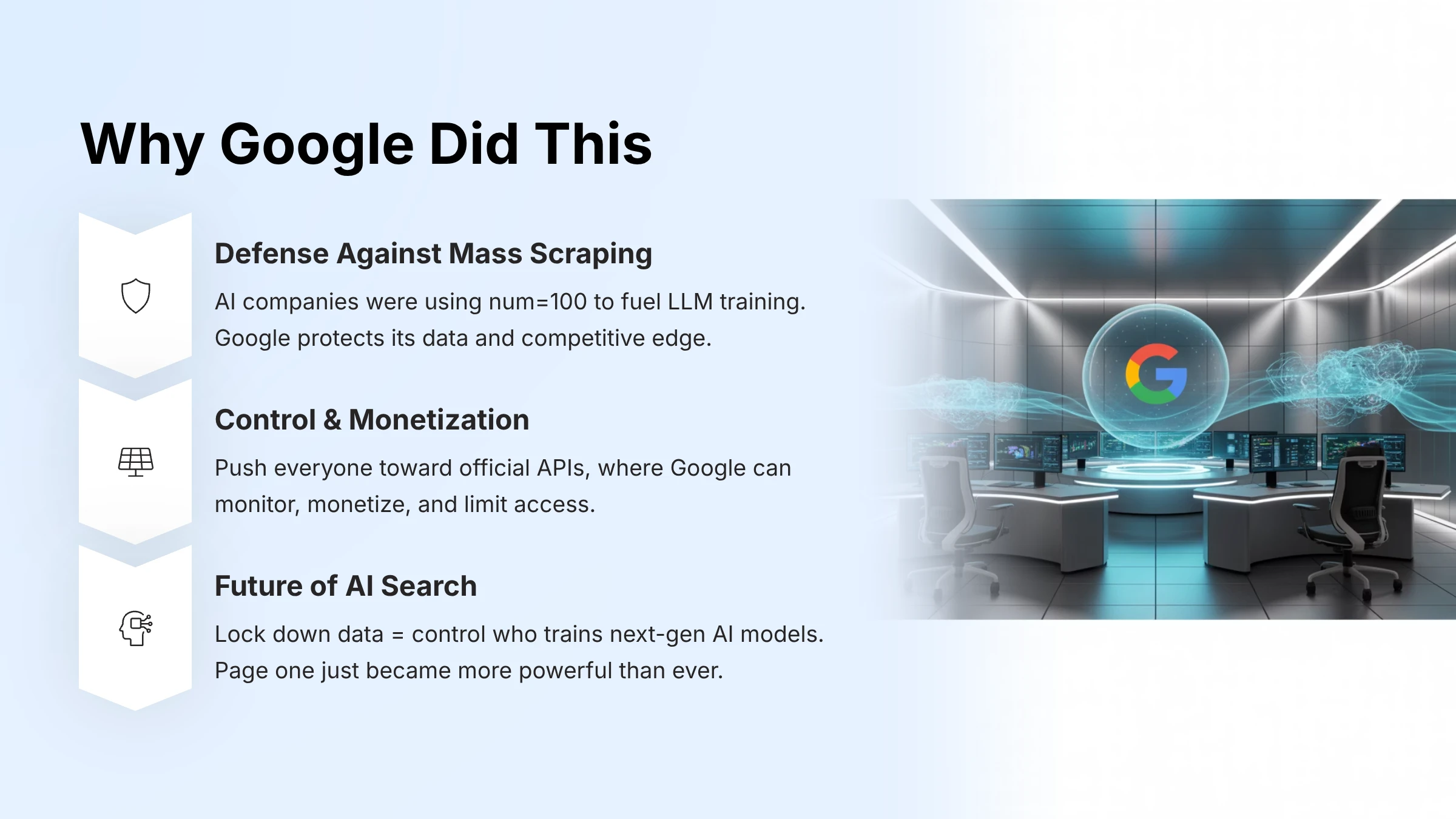
So why did Google do this? The research shows three big reasons:
First, it's a defensive move against mass scraping. AI companies and SEO tools were using num=100 to pull huge chunks of Google's index—fuel for training large language models. By killing the shortcut, Google protects its data, its infrastructure, and its competitive edge.
Second, it's about control. Google wants to push everyone toward their official APIs—where they can monitor, monetize, and limit access. No more free lunch.
Third, it's about the future of AI search. If Google locks down its data, it controls who gets to train the next generation of AI models. And with AI Overviews now appearing in 29% of searches, that control matters more than ever.
The truth is, this move just made page one more powerful than ever. And it introduced a new gatekeeper dynamic that changes everything.
What This Means for Your Business Right Now
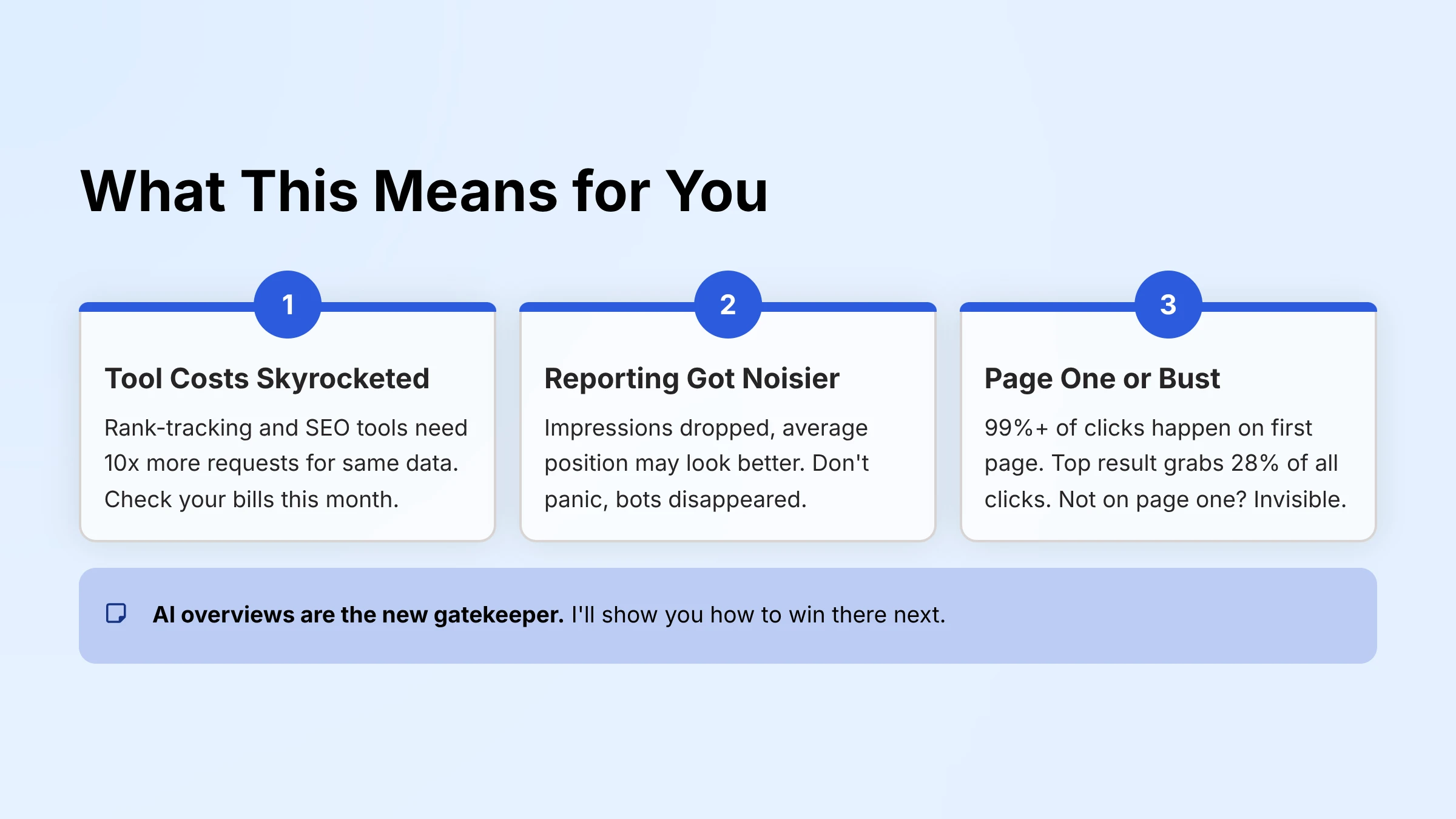
Here's what this means for you—right now:
Your rank-tracking costs just shot up. Some tools now need 10 times more requests to get the same data. Check your tool bills this month—you might see some surprises.
Your reporting is noisier. Impressions dropped, but average position may look better. Don't panic. Most of the drop is just bots disappearing. The real question is: are your clicks and conversions affected?
The game has shifted to page one. According to Backlinko's research, over 99% of clicks happen on the first page. The top result grabs about 27.6% of all clicks. The top three results? They get 54.4% of all clicks combined.
If you're not on page one, you're basically invisible.
Good luck getting anywhere with page two rankings in 2025.
The New Gatekeeper: AI Overviews
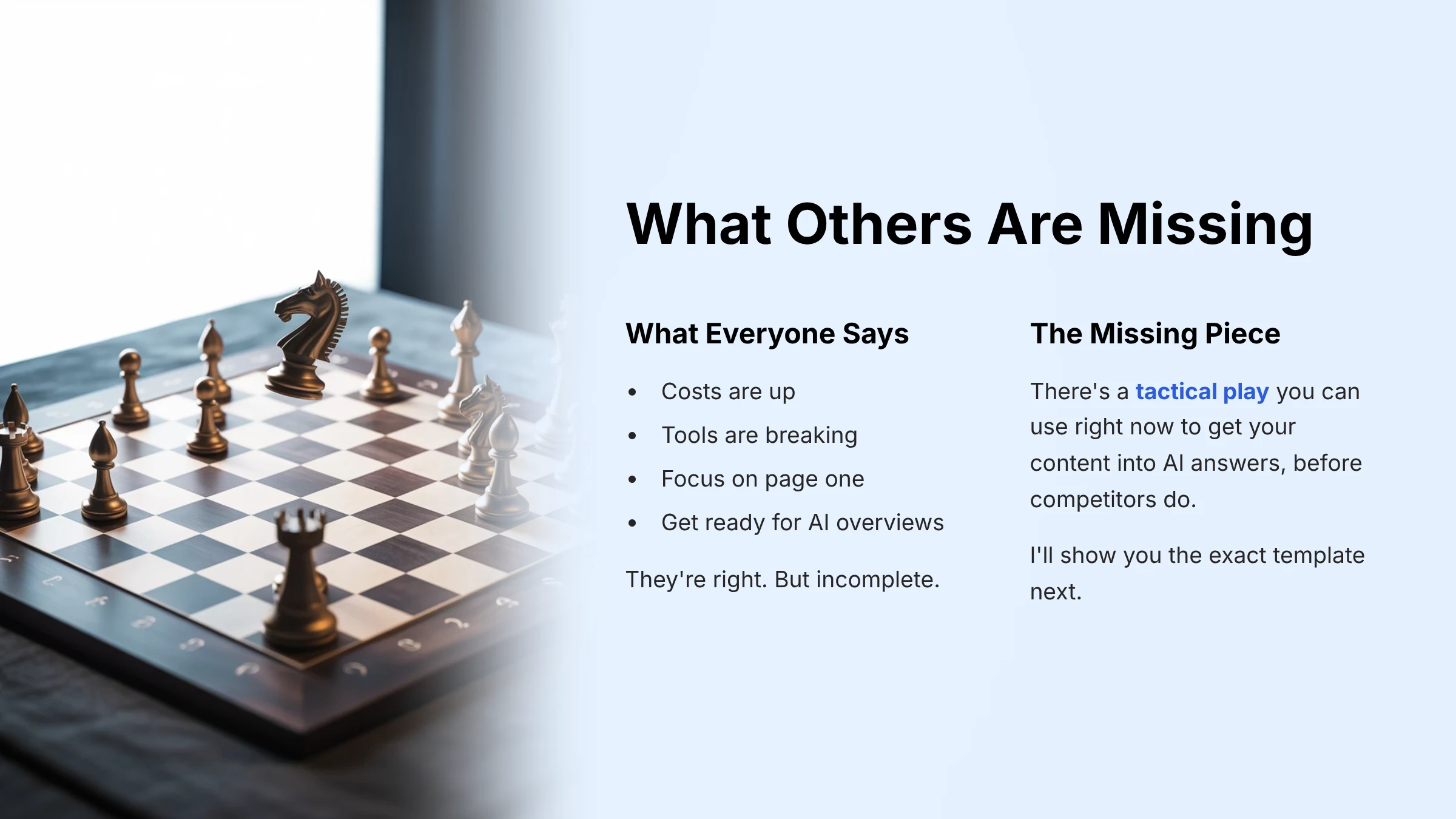
But wait—there's something even more important than page one rankings now.
These AI-generated summaries are appearing at the top of more and more searches. They're pulling information from multiple sources and presenting it directly in the results—before users even see the traditional blue links.
Here's what you need to know:
AI Overviews link to about five sources per query
52% of those sources also appear in the top 10 organic results
But that means 48% don't—they're getting visibility without traditional rankings
If you're not optimizing for AI Overviews, you're missing a massive opportunity.
Getting serious about AI-powered search optimization? Join my free masterclass on building Smart AI Websites that rank on Google AND LLMs. I'll show you the exact systems I use to capture visibility across all search platforms.
Your 5-Step Survival Playbook

Alright, let's get practical. Here's your five-step survival playbook for navigating this change:
1. Focus on Page One and Conversion (BOFU)
Over 99% of clicks are on page one. If you're not there, you're nowhere.
Restructure your most important pages for transactional intent. Treat the top 10 as your new battlefield.
Consolidate related pages, strengthen your intent signals, add schema markup, and make your call-to-action impossible to miss.
2. Feed the AI Overviews (Rank in AI Answers)
AI Overviews are the new gatekeeper. If you're not in them, you're invisible to a growing chunk of searchers.
Create concise, authoritative, answer-first content formatted specifically for LLMs.
Start with a short answer block at the top (50-70 words)
Add 3-5 bullet points with supporting facts or steps
Include a short FAQ or "People also ask" section
Add schema markup (FAQ, HowTo, or Article)
Make sure your page loads fast and is mobile-friendly
Let me show you a quick example. Instead of burying your main point five paragraphs deep, do this:
Bad approach: "In this comprehensive guide, we'll explore the various methods and techniques that businesses can implement to improve their customer retention strategies, starting with..."
Good approach (AI-friendly): "Customer retention improves by 27% when businesses send personalized follow-ups within 24 hours. Here's how to set it up..."
See the difference? Lead with the answer. Then expand with proof.
3. Instrument Attribution
When impressions wobble, you need to know what's actually driving revenue—not just what looks good in a dashboard.
Set up call tracking, UTM links, and closed-loop reporting.
Map every ad to a call, every call to your CRM, every CRM entry to revenue. This is how you survive reporting chaos.
4. Reduce Dependency on Scraped Datasets
Scraping is getting harder and more expensive. Plus, the data might not even be accurate anymore.
Build your own first-party data capture and knowledge base.
Use Smart AI Website chat, missed call text-back, and real-time lead capture. Own your data instead of renting it from third-party tools.
Ready to set up first-party data capture? Check out GoHighLevel's 30-day free trial—it's the all-in-one platform I use for CRM, automation, chat, SMS, and lead tracking. When you sign up through my link, you get my Smart AI Website Training as a bonus.
5. Cost & Tool Audit
Tool costs are up. Don't pay for what you don't use—or what doesn't work anymore.
Audit your stack, negotiate with vendors, and build lightweight in-house solutions if needed.
Use a simple decision matrix: Keep, Replace, or Build. For each tool, ask: "Is this still giving me accurate data? Is it worth the new price?"
The Business Opportunity Nobody's Talking About
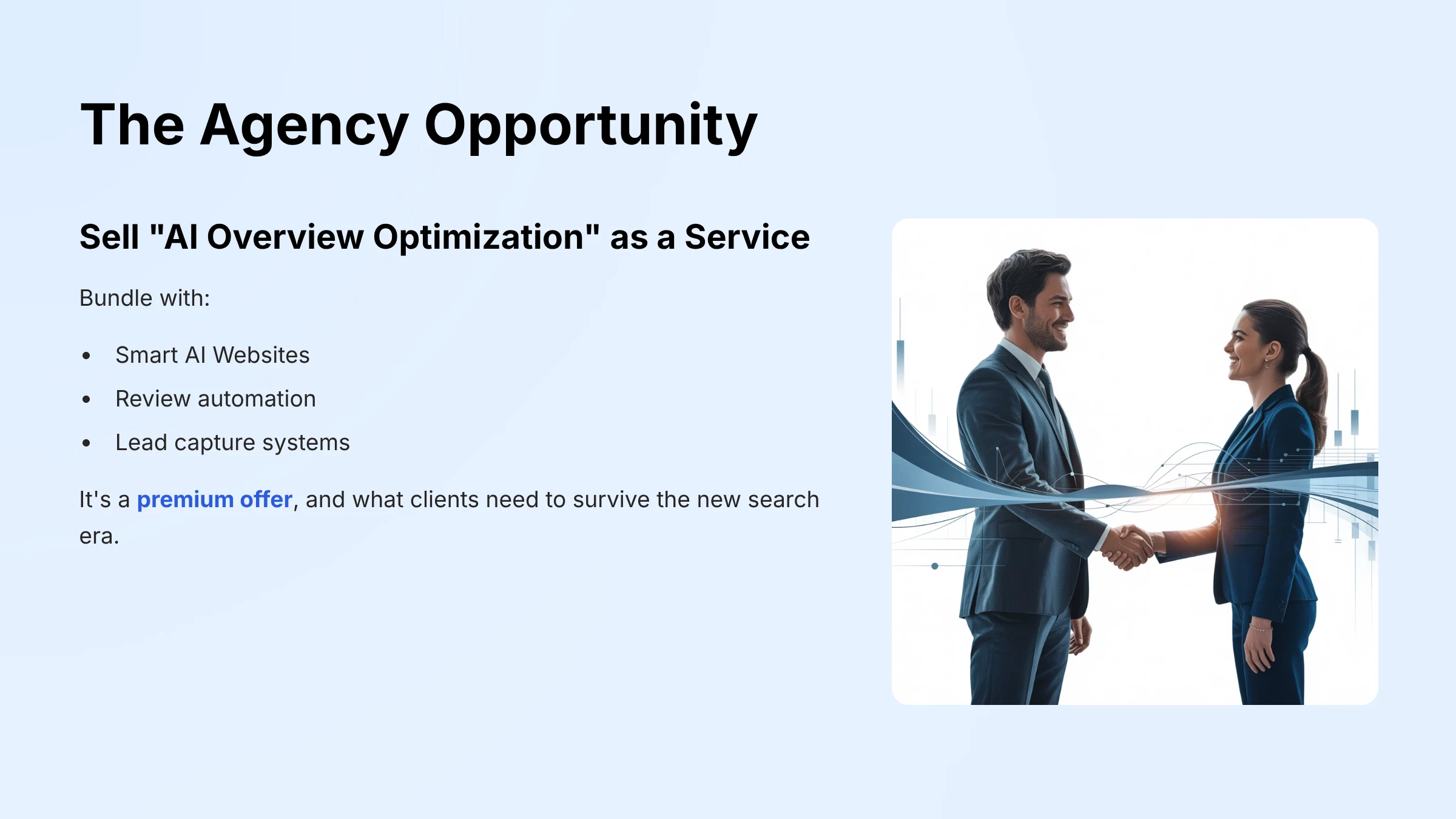
Here's the opportunity: Agencies and consultants can now sell "AI Overview optimization" as a premium service.
Bundle it with Smart AI Websites, review automation, and first-party data capture. It's what clients need to survive the new search era—and most of them have no idea how to do it themselves.
Think about it. Every local business, every service provider, every consultant who relied on traditional SEO is now scrambling. They're seeing their impressions drop, their tools break, and their reports look worse—even though their actual business might be fine.
That's where you come in.
Let's Recap: The Three Biggest Risks Right Now

Losing visibility because you're not on page one
Getting left out of AI Overviews while your competitors get cited
Relying on scraped data that's getting more expensive and less reliable
Three Actions to Take This Week
Restructure your key pages for page one—focus on transactional intent and schema markup
Use the AI Overview template I showed you above—answer-first content that LLMs can easily cite
Capture every lead with first-party tools—stop relying on data you don't own
The truth is, Google changed the game. Now we adapt.
The Bottom Line
Look, I get it. This feels like another curveball in an already chaotic landscape. First it was mobile-first indexing. Then core updates. Now it's AI Overviews and parameter removals.
But here's what I've learned after years of navigating these shifts: The businesses that win aren't the ones with perfect timing. They're the ones that adapt fast.
Google didn't nuke num=100 to hurt you. They did it to protect their moat against AI companies scraping their index. The fact that it broke some SEO tools and inflated reports? That's just collateral damage.
Your site didn't disappear. Your rankings didn't tank. The phantom audience just left the theater—and now you're seeing what real visibility actually looks like.
So here's what to do next:
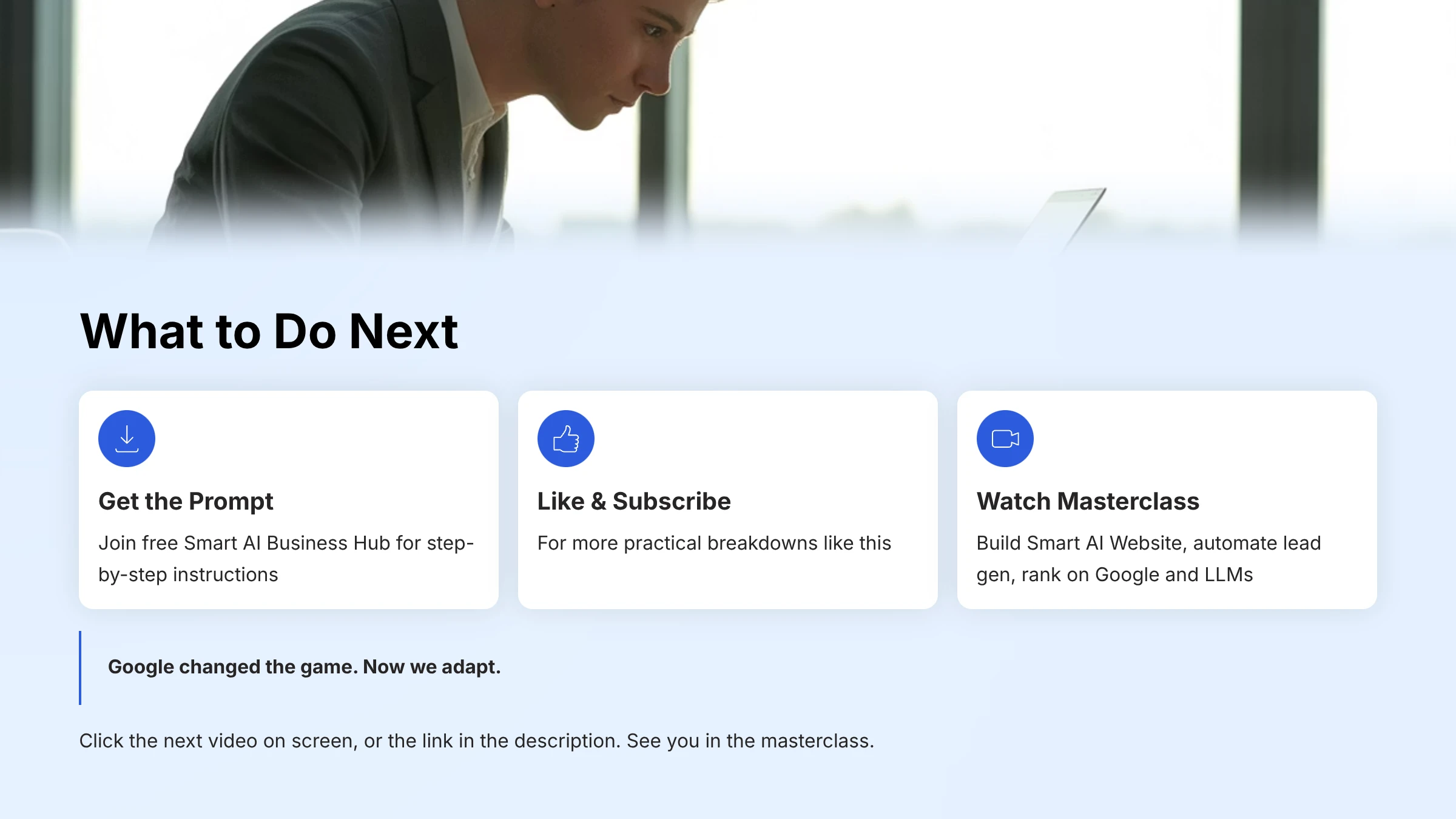
Join the Smart AI Business Hub for templates and checklists. Like and subscribe if you want more practical breakdowns like this. And if you're a business owner, coach, consultant, or agency owner—watch my free masterclass on building Smart AI Websites that rank on Google AND LLMs, you can find it inside the Hub.
The future of search is here. And with the right strategy, you can dominate it.
Disclaimer: Results are not guaranteed. Individual results depend on effort, market conditions, and implementation. GoHighLevel® is a trademark of its owner; this content is not endorsed by or affiliated with GoHighLevel.
Copyright © OnlineMarketer.ai – All rights reserved.
This blog is for educational and entertainment purposes only. It does not constitute business, legal, financial, or investment advice, and should not be interpreted as such. The views and opinions expressed are based on publicly available information and are intended to spark critical thinking and informed decision-making.
OnlineMarketer.ai does not guarantee the accuracy, completeness, or timeliness of any information presented. Always consult a qualified professional before making any decisions related to business, marketing, or technology.
FAIR USE NOTICE:
Some content used in this blog may include copyrighted material for the purpose of commentary, criticism, news reporting, teaching, or education - all of which falls under Section 107 of the Copyright Act as “fair use.” No copyright infringement is intended.
If you are the copyright owner of any material used and have concerns about its use, please email [email protected] and we’ll resolve it promptly.
AFFILIATE DISCLOSURE:
Some of the links in this blog may be affiliate links. This means we may earn a small commission - at no extra cost to you - if you decide to purchase through those links. We only promote tools and platforms we personally use and believe in.
